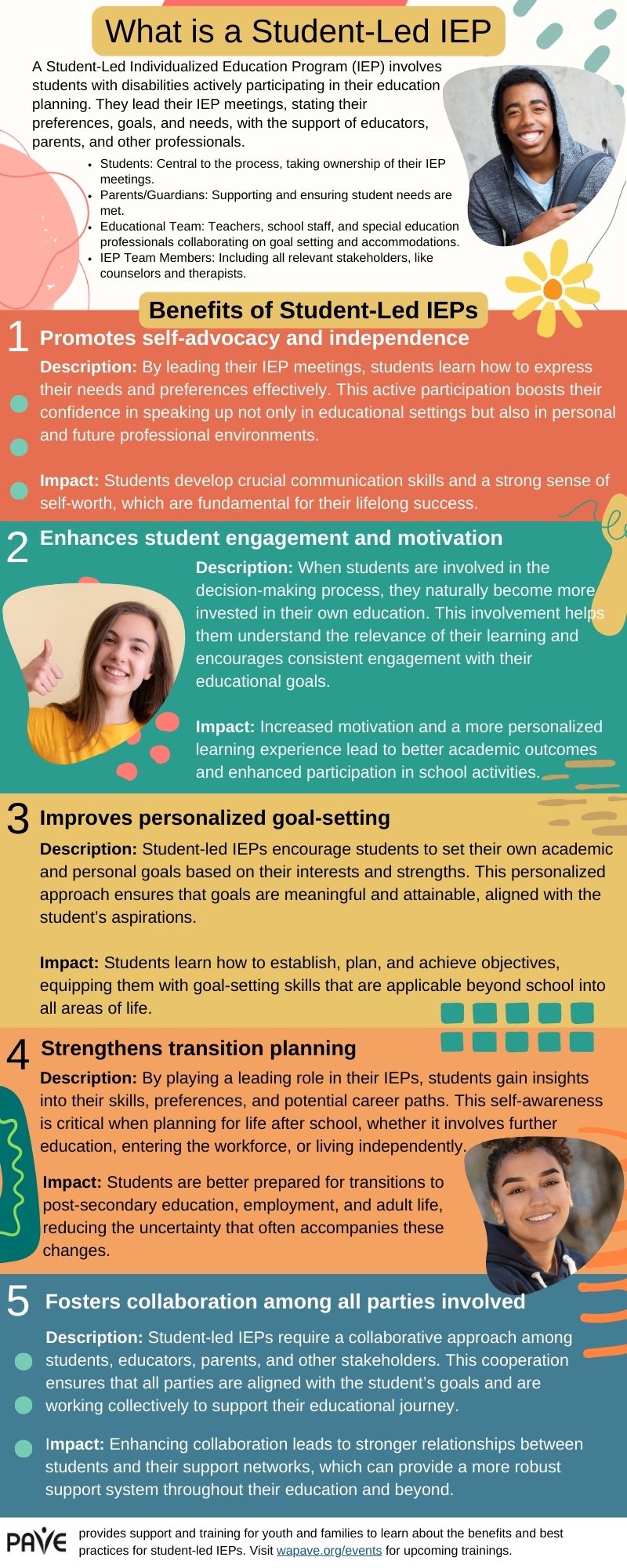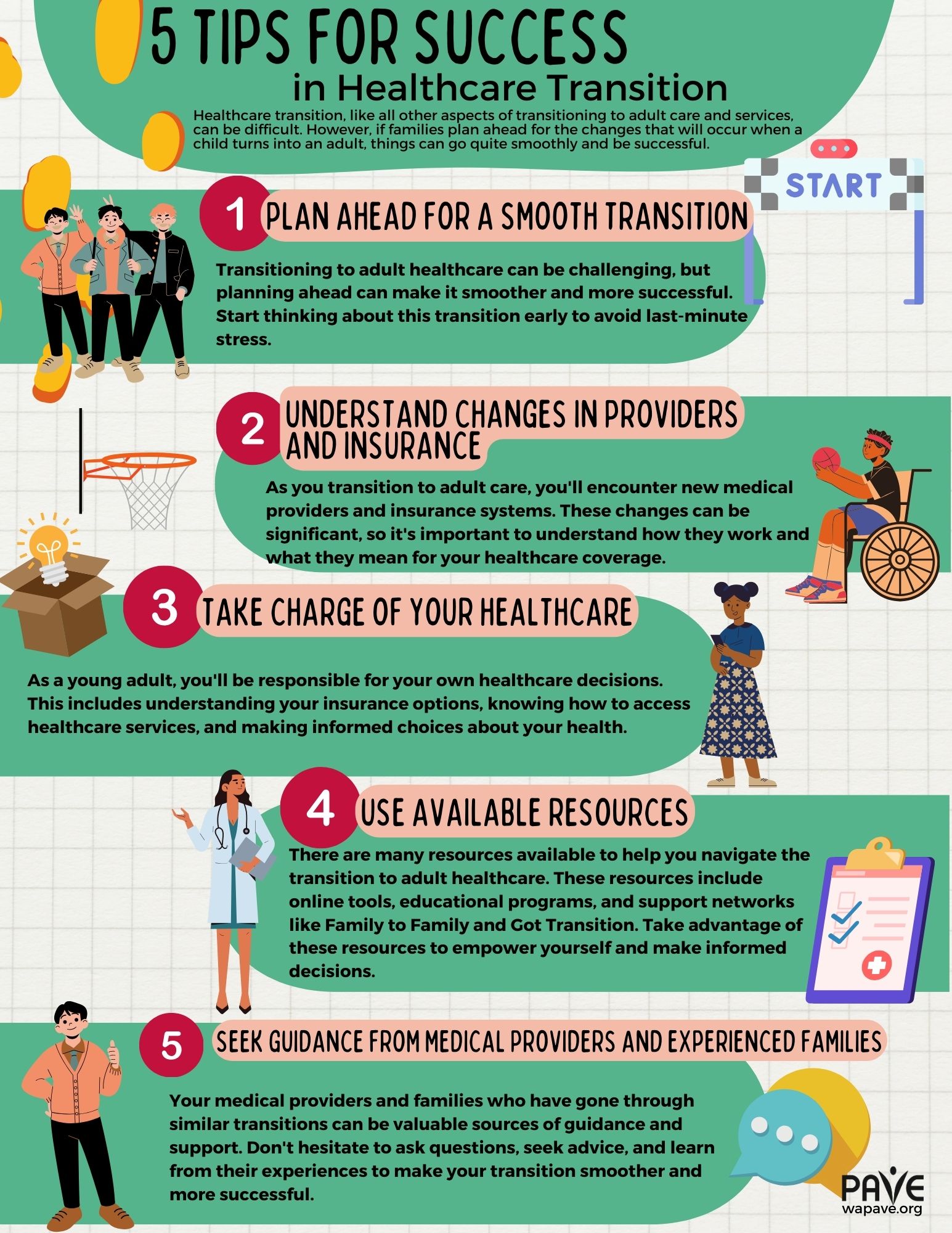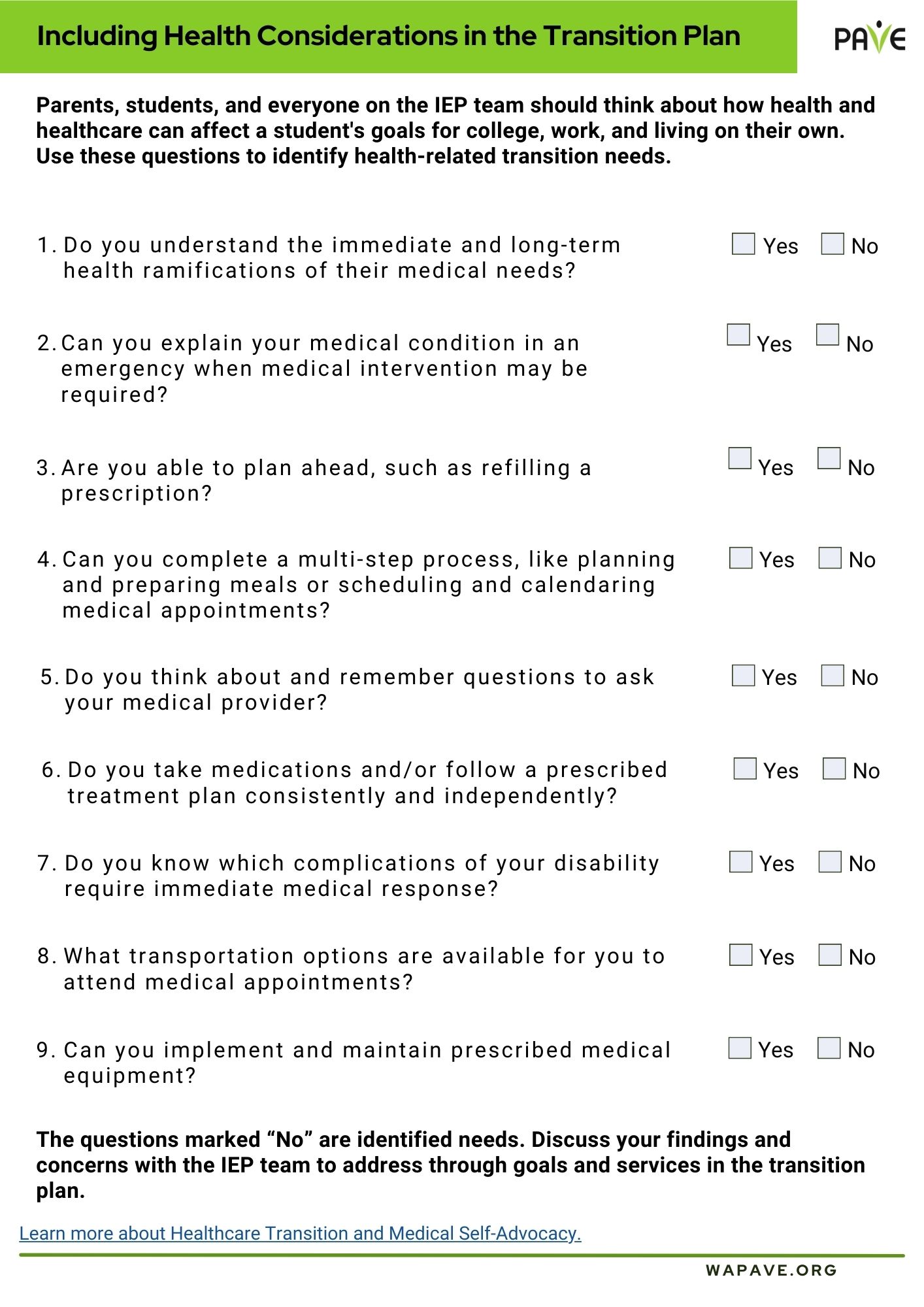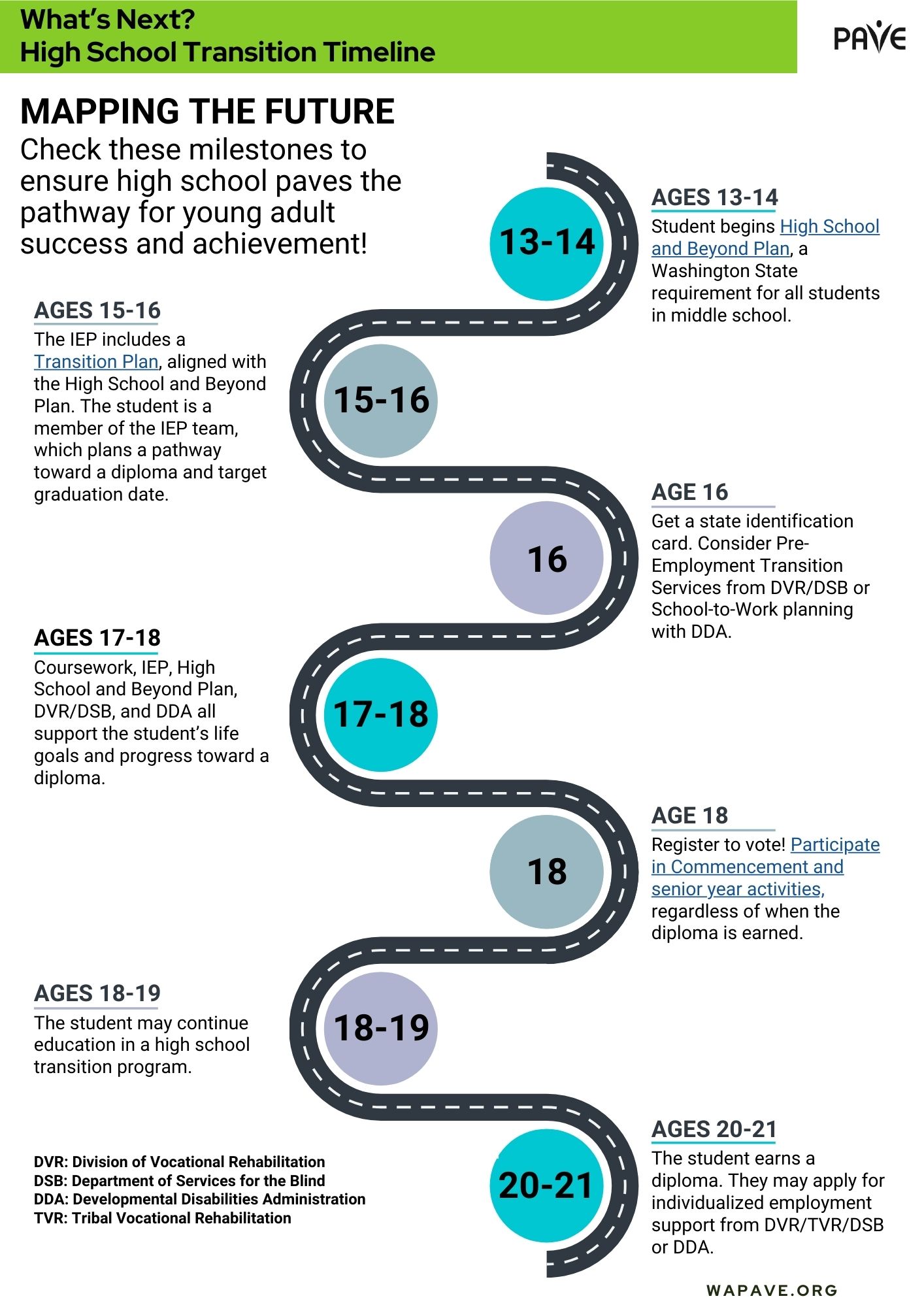Washington State requires all students to build a future-focused plan starting in middle school that can be tailored to match their goals and strengths. When students have IEPs, this planning must align with their transition services and support needs. Families play a key role in helping students explore options, build self-advocacy skills, and stay on track for graduation and beyond.
A Brief Overview
- All public school students in Washington State start their High School and Beyond Plan (HSBP) by 8th grade, with activities often beginning in 7th grade.
- The HSBP is a personalized plan that helps students think about their strengths, goals, and the steps needed for life after high school.
- For students with disabilities, the HSBP must align with their IEP transition plan to ensure classes and supports match their future goals.
- The HSBP is updated every year to reflect changing goals and progress.
- It includes career interests, post-high school education plans, course selections, financial aid info, and a resume of schoolwork and activities by 12th grade.
- Schools must offer support if students struggle in subjects like reading or math, and these supports should be included in the plan.
- Families play a key role by staying informed, asking questions, encouraging self-advocacy, and connecting with community resources.
What Is the High School and Beyond Plan?
Whether you’re in middle school or already in high school, it’s never too early—or too late—to start thinking about what comes next. That’s where Washington’s High School and Beyond Plan comes in. All public school students in Washington are required to start an HSBP by 8th grade, and most begin the process in 7th grade with activities that help them discover their strengths and career interests. Schools are responsible for helping students create their first plan and update it every year to reflect new goals, track progress, and guide course selections. Students transferring into a Washington public school can develop an HSBP with their school up until 12th grade.
For students with disabilities, the HSBP plays an even more important role. It works together with your IEP transition plan to support your dreams and prepare you for your future after high school. When the HSBP and IEP are aligned, they make sure your classes, services, and supports match your long-term goals—whether that includes a job, college, technical training, or independent living.
The HSBP is like a personal roadmap that helps you plan for the next chapter of your life. It helps answer three big questions:
- Where am I now?
This is about what you are good at, what you like, and what is hard for you. Think about how your disability might affect your schoolwork and what help you might need.
- Where do I want to go?
Think about your hopes and dreams—do you see yourself in college, working a certain job, living on your own, or something else?
- How do I get there?
This includes your goals, high school classes, learning accommodations, and the people who support you.
Your plan should be updated every year as you grow and your ideas change. It’s not just a one-time checklist—it’s a living tool that grows with you.
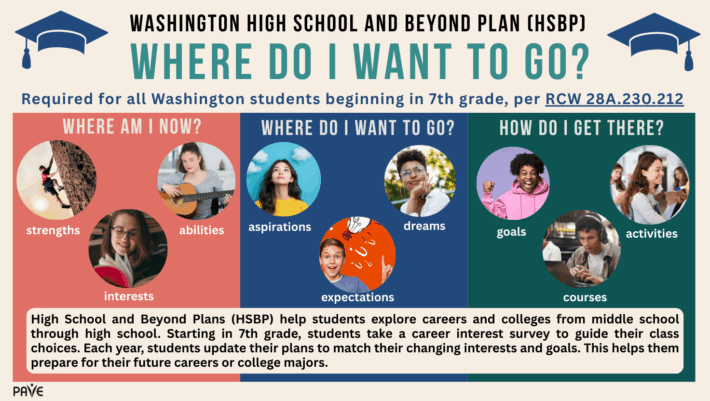
Download the HSBP infographic in:
English | Chinese (Simplified) 中文 (Zhōngwén) | Korean 한국어 (Hangugeo) | Russian Русский (Russkiy) | Somali Soomaali | Spanish Español | Tagalog | Ukrainian українська | Vietnamese Tiếng Việt
How do the HSBP and IEP work together?
If you have an Individualized Education Program (IEP), it must include a Transition Plan by the time you turn 16. This part of the IEP is all about preparing for your life after high school graduation. Your IEP team will talk about things like:
- Your graduation timeline
- Work goals and job training
- Continuing education
- Independent living
- Transportation and daily living skills
Some students with IEPs can stay in school until age 22 if they need more time to build skills for work, living on their own, or reaching other goals.
The HSBP and IEP transition plan are required to match and work together. That way, the classes you take and the supports you receive during high school will line up with your goals for the future.
What goes into your HSBP?
Every student’s HSBP is different, but most plans include:
- Career interests and job ideas
- Post-high school education goals (like college or trade school)
- A course plan to meet graduation requirements and personal goals
- Information about financial aid, scholarships, and other support for education
- A resume or summary of schoolwork, job experience, and community activities by 12th grade
If you’re struggling in classes like reading or math, the school must offer you support and explain it in your HSBP. This helps you stay on track to graduate.
What should I think about for life after high school?
As you work on your HSBP and IEP, here are some questions to think about. You can talk about these with your family, IEP team, or trusted adults.
Jobs, Trades, & Work
- What kinds of jobs sound interesting to you?
- What training or help would you need to do those jobs?
- Does your IEP include community work experience?
Education After High School
- Do your personal goals include college or technical school?
- What accommodations would you need there?
- Have you talked to the Disability Support Services office at a campus?
Living Arrangements
- Will you live with your family, a friend, or on your own?
- How will you cook, clean, shop, and get around town?
- Does your IEP include goals for independent living?
Community and Social Life
- What will you do for fun?
- Are there clubs, support groups, or activities you’d like to join?
- How will you make and keep friendships?
How can families support students in building their HSBP?
Families are essential partners in planning for your child’s future, and your involvement plays a crucial role in their success. Here are ways you can actively support your child throughout this process:
- Stay informed and ask questions. Regularly communicate with your child’s teachers, counselors, and school staff to stay updated on meetings, activities, and resources related to your child’s goals. Don’t hesitate to ask for clear explanations about the options and supports available.
- Attend IEP meetings. After a student turns 18 (the age of majority), educational rights transfer from the parent to the student. This includes the right to attend and invite others to IEP meetings, such as their parent or guardian, especially during transition planning and discussions about the HSBP.
- Review progress and update goals annually. Make it a habit to review your child’s progress and goals at least once a year. If your child’s interests, strengths, or needs change, share this information with the school so plans can be adjusted accordingly.
- Encourage your child to speak up. Help your child build confidence by discussing their feelings, goals, and concerns about school. Practice how they can share their thoughts during meetings or conversations with adults involved in their education.
- Practice setting goals together. Collaborate with your child to create small, manageable goals related to academics, social skills, or independent living. Celebrate their successes to boost motivation and help them develop ownership of their future.
- Request clear and accessible communication. If you need information in a language other than English or in a format that’s easier to understand, ask the school to provide it. Schools are required to communicate in ways that enable your full participation.
- Stay connected and involved. Ask the school to notify you well in advance about important meetings, workshops, or events where your input is needed. Your presence helps make sure your child’s needs and preferences are fully represented.
- Connect with community resources. Look for local organizations, support groups, or agencies that help students with disabilities prepare for life after school. These resources can provide valuable guidance, training, and opportunities.
By taking these proactive steps, you empower your child to take charge of their future while making sure they receive the support they need every step of the way.
How can I speak up for myself?
Students—this is your chance to shine! When you lead your own IEP meetings or share your goals, you are practicing self-advocacy. PAVE offers a Student Input Form in the article Students: Get Ready to Participate in Your IEP Meeting with a Handout for the Team. This form helps you tell the team:
- What you enjoy
- What you’re good at
- What support you need
These answers can guide your IEP and HSBP so the adults around you know how to help you to meet the goals you set for your future and accomplish your dreams!
Final Thoughts
The High School and Beyond Plan is all about you—your dreams, your choices, and your future. With the right tools and people supporting you, you can create a plan that fits your goals and helps you succeed. Remember to start planning early, keep your plan updated, and always aim high for your future.
Learn More
- Explore the State Board of Education’s High School & Beyond FAQs to get answers about when the HSBP starts, what it includes, and how families can stay involved in the process.
- Download the Aligning HSBP and IEP Transition Plans guidebook from the Office of Superintendent of Public Instruction (OSPI) for tools and tips to help schools and families make sure the HSBP and IEP transition plan work together.
- Read PAVE’s School-to-Adulthood: Transition Planning Toolkit for help with career planning, graduation options, and how to connect your IEP and HSBP.
- Check out the What’s Next? Transition Planning Timeline to see a visual guide of important steps from middle school through age 21.
- Use PAVE’s Transition Triangle worksheet to understand how schools, community supports, and vocational agencies can help you plan for adult life.
- Download the Planning My Path Toolkit for Young Adults with worksheets and activities that help you think about your goals for school, work, and independent living.
- Learn about job readiness and support services through Ready for Work: Vocational Rehabilitation Guidance, including information about Pre-Employment Transition Services (Pre-ETS) in Washington.
- Use the Transition Toolkit from the Center for Parent Information and Resources (CPIR) to find national resources that help students and families prepare for life after high school.


